
Our annual survey reveals the latest trends in how software-as-a-service (SaaS) companies are capitalizing sales commissions and software development costs, including the impact of regulatory changes and a proposed model for initial development cost capitalization.
Sales commissions and software development costs (including website or application development costs) remain among the top expenditures for SaaS companies. Chief financial officers, chief accounting officers and other SaaS finance and accounting executives need to continually evaluate and monitor the industry for emerging trends pertaining to the accounting of these costs.
Our 2023 SaaS survey provides a valuable tool to gauge how your organization compares to its peers in these key areas. It includes 100 of the top publicly traded SaaS companies (ranked primarily by market capitalization). We collected the survey information from participants’ Form 10-Ks, reflecting data for the most recent fiscal year ending prior to June 1, 2023. In addition to looking at capitalization over time, we also examined capitalization by revenue and auditor.
Table of Contents
For reference, here are the rules specific to development cost and commission capitalization.
ASC 606, enacted in 2018, mandates that companies capitalize sales commissions if such costs are expected to be recovered through future revenues unless the amortization period is one year or less.
The capitalization of costs incremental to obtaining a contract and determining the amortization period is one of the most significant areas affected by ASC 606, as companies no longer have the option to immediately “expense as you go.”
SaaS development costs are subject to “internal use” software capitalization rules, which typically have a longer time window for eligible costs to be capitalized, versus the “external use” rules for software licensing companies. The tables below summarize the applicable Financial Accounting Standards Board (FASB) rules.
| SaaS | ||
|---|---|---|
| Internal Use Software | SUBTOPIC 350-40 | Cost capitalization begins when the preliminary project stage is finished, management has committed to funding the project and it is probable that the project will be completed and the software will perform the function intended. Capitalization ceases when the project is substantially complete and is ready for its intended purpose. |
| Website Development Costs | SUBTOPIC 350-50 | Capitalize costs incurred to purchase software tools, or costs incurred during the application development stage for internally developed tools. |
| Traditional Software License | ||
|---|---|---|
| Costs of Software to Be Sold, Leased or Marketed | SUBTOPIC 985-20 | Capitalization begins when technological feasibility has been established and ends when the product is available for general release. |
In December 2017, the Tax Cuts and Jobs Act (TCJA) amended IRC Section 174 to require R&D expenditures to be capitalized and amortized over a period of five to 15 years for amounts paid beginning in tax year 2022. Internal software development costs were specifically noted and must be capitalized and amortized. Year one (2022) created a significant tax impact because only half-year amortization is allowed.
As a result, many SaaS companies now may have substantial taxable income. We’ve seen some companies face three to four times the previous year’s tax liability as these regulatory changes have put them in a taxable position for the first time. Companies may assume they have tax attribute carryforwards to offset the income (e.g., net operating losses and tax credits), but these are often limited or not available under IRC Section 382 and the amended Section 174.
Stakeholders, the C-suite and especially the treasury and tax functions of SaaS companies must adopt a strategic approach to minimize the financial impact of the new rules. Working with your tax advisor to plan and maximize efficiency is critical for your bottom line.
Consider these actions:
In 2022, the FASB added a project to its technical agenda to modernize accounting and enhance transparency for software costs, including costs to internally develop and acquire software for internal use (ASC 350-40) or for sale (ASC 985-20). In April 2023, the board decided to focus on the initial development cost model (the “single model”) before considering presentation and disclosure.
The single model requires companies to capitalize all direct software development costs (internal and external use) “when it is probable that the software project will be completed, and the software will be used to perform the function intended.”2
Currently companies determine if their software costs fall under ASC 350-40 or ASC 985-20. The proposed single model eliminates this decision and replaces the concept of technological feasibility (ASC 985-20) with the concept of “probable” completion, derived from ASC 350-40 with revision. ASC 350-40 uses the stages of development to determine when to capitalize a cost, whereas the proposed single model uses a list of indicators:
Armanino consultant Andrew Hyde, a former CFO for SaaS companies such as Salesforce, OptionEase and Solid Instance, shared these thoughts on the FASB proposal:
The single model approach would bring welcome clarity and consistency to the treatment of software development costs. Why should these costs be treated differently if the project is devoted to an internal or an external application?
In either case, under present standards, FASB recognizes the creation of an asset having long-lived value to the enterprise. This approach reflects what is already occurring as software companies align with SaaS companies’ practices, moving away from the “technical feasibility” standard. The FASB would be well served to adopt the single model approach to recognize a natural evolution taking place in the market.
The FASB will continue deliberating, including having discussions with software companies and investors, to finalize the criteria for capitalization. Issues to look for include:
ASC 606 dramatically changed the revenue recognition landscape in 2018, effectively mandating that companies capitalize commissions, if material. As a result, the capitalization rate in the 2019 survey (66%) tripled compared to the 2017 survey (22%). In 2023, registrants capitalizing commissions remained high at 86%, increasing only 1% from 2022. This may represent a leveling off of sales commission capitalization.
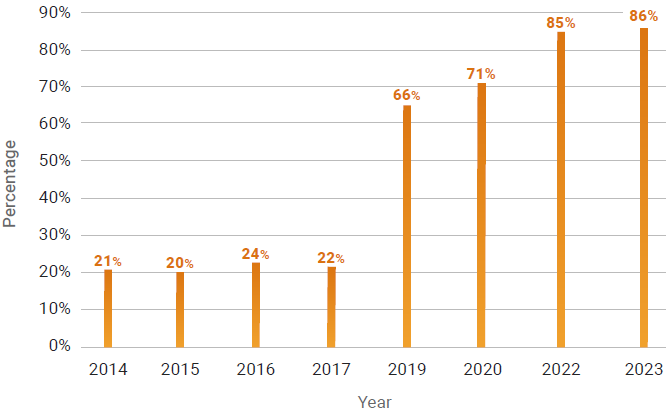
*We did not publish a survey in 2018 or 2021.
In 2023, companies that did not disclose commissions capitalized (either claimed commissions were immaterial or were related to deals of less than one year) represented 14% of companies surveyed, down from 34% in 2019. This number is only 1% smaller than last year, however, it remains higher than expected, given that most SaaS companies pay significant commissions and sales teams typically focus on multi-year deals.
Not surprisingly, the SEC has issued comment letters to certain registrants concerning how they account for costs incurred to obtain contracts. Examples of such comments (adapted) are as follows:
The SEC notes as a result of adopting ASU 2014-09, Revenue from Contracts with Customers (Topic 606), Registrant identified that the new standard required it to adjust its presentation of costs associated with selling extended service plans and treatment of the amortization of certain bonus and profit-sharing arrangements related to third-party credit card programs. The capitalization and amortization of ‘certain costs‘ associated with selling extended service plans was discontinued and are now expensed as incurred. Please tell us the nature of these ‘certain costs’ and why your accounting complies with ASC 606. Please also tell us the nature of the costs that are capitalized.
Registrant discloses that it pays sales commissions based on contract value upon signing a new arrangement with a customer and upon renewals. Registrant further discloses that it amortizes deferred sales commissions over the expected customer life, which is approximately five years. Please tell us, and revise to clarify, whether commissions paid upon renewal are commensurate with initial commissions. Also disclose how commissions paid for renewals are considered in your five-year period of benefit for the initial commission. Finally, disclose the period of time over which you amortize commission costs related to contract renewals. Refer to ASC 340-40-35-1 and 340-40-50-2(b).
The SEC notes that the Registrant has applied the practical expedient related to commissions and continues to expense the commissions as incurred since the majority of its contract periods are one year or less. The SEC also notes that you have applied the practical expedient related to quantifying remaining performance obligations since the majority of your contracts are one year or less. Please tell us if you have applied these practical expedients to contracts with terms in excess of one year and, if so, how your application of these practical expedients is consistent with ASC 340-40-25-4 and ASC 606-10-50-14.
The percentage of companies capitalizing software development costs decreased by 2%, going from 72% in 2022 to 70% in 2023. This is the second year this percentage has not grown, perhaps indicating a leveling out of the number of companies seeking to capitalize these costs.
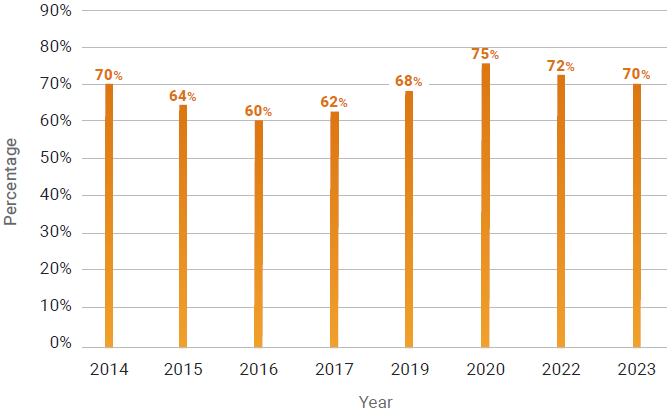
*We did not publish a survey in 2018 or 2021.
In this year’s survey, we also sorted the firms by revenue into four brackets, with 25 firms in each bracket: $0 to $488 million, $489 million to $989 million, $990 million to $2.2 billion and over $2.2 billion.
In 2020, the data showed that companies with higher revenue tended to capitalize on software development costs more often than companies with relatively lower revenue. However, beginning in 2022 and continuing into this year, the reverse was true. The data shows that companies with lower revenue tend to capitalize on software development costs more often than companies with higher revenue. In 2023, companies in the three lower revenue quartiles capitalized development costs more than 70% of the time, while only 52% of companies in the largest quartile ($2.2B+) did so.
In 2023, the average capitalized software development among the companies in the different quartiles ranged from 1.7% to 2.4% of revenue. This is slightly less varied than 2022, where the average capitalized software costs of companies in the different quartiles ranged from 1.6% to 2.5% of revenue.
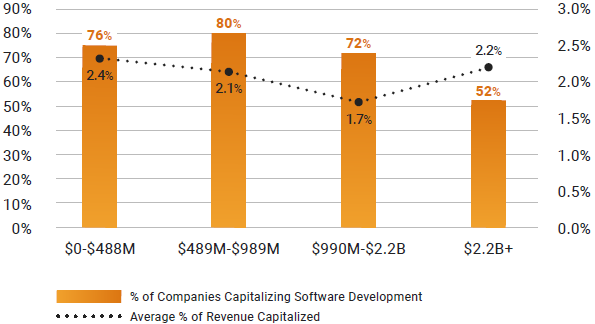
In 2022, companies with relatively lower revenue tended to capitalize sales commission costs more often than companies with higher revenue. The same is true for 2023. Roughly 72% of companies in the $2.2 billion and over bracket capitalized commission costs, while 96%, 92% and 84% of companies in the $0 to $488 million, $489 million to $989 million and $990 million to $2.2 billion brackets capitalized commission costs, respectively.
The amount of commission costs capitalized as a portion of revenue trended downwards across all revenue quartiles in 2023. Overall, an average of roughly 6.55% of revenues were capitalized in 2023 compared to 7.7% in 2022. Interestingly, the largest revenue bracket ($2.2 billion and over) continues to capitalize the lowest percentage of revenue, only capitalizing commissions at a rate of 4.6% of revenues.

We also analyzed capitalization practices based on the companies’ independent registered public accounting firms (auditors). The data showed a disparity in practices based on the audit firm.
Of the 100 companies surveyed, 94 used Big Four auditors. The graphs below show the capitalization practices of companies for each Big Four auditor and for the six companies that did not use a Big Four audit firm.
Among the registrants audited by the Big Four, 76.9% of Deloitte’s clients capitalized software development costs in 2023, while EY had the lowest percentage at 62.5%. Notably, the percentage of Deloitte clients capitalizing software development costs decreased from 92.3% in 2022 to 76.9% in 2023, the largest change of any of the firms. Among registrants audited by other firms (not Big Four), 33.3% capitalized software development costs.
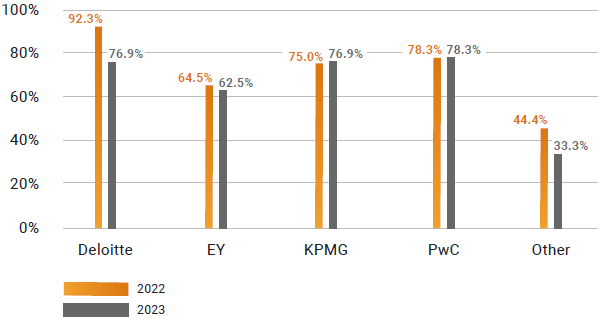
Among the registrants audited by the Big Four, PwC had the highest percentage of clients (100%) that capitalized commissions in 2023, while EY had the lowest percentage at 78.1%. Similar to the capitalization of software development costs, Deloitte saw a decrease in the percentage of clients capitalizing commissions (from 92.3% in 2022 to 84.6% in 2023). Among registrants audited by other firms (not Big Four), there was an increase from 77.8% capitalizing commissions in 2022 to 83.3% doing so in 2023.
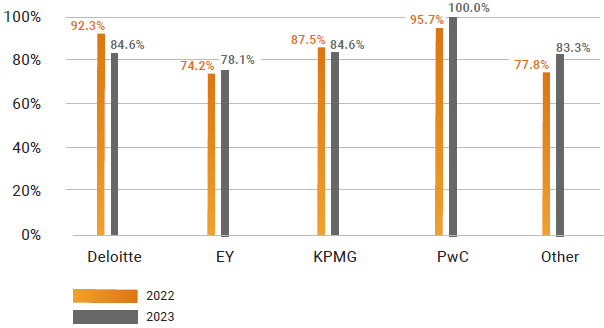
In light of the survey findings and the ASC 606 standard, SaaS companies should continuously evaluate their decisions on capitalizing software development and commission costs, as there are several short- and long-term implications. They should also consult with their auditors and, ultimately, adopt the method they believe most closely aligns with the intent of the rules.
Finally, SaaS companies should keep a close eye on the FASB proposal as it moves forward because it may significantly alter the rules related to capitalization of development costs.
Download the full research report below to view the top 100 SaaS companies surveyed in 2023 and footnotes from the companies’ 10-Ks.
Download prior years’ surveys:


